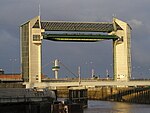
The River Hull is a navigable river in the East Riding of Yorkshire in the north of England. It rises from a series of springs to the west of Driffield, and enters the Humber estuary at Kingston upon Hull. Following a period when the Archbishops of York charged tolls for its use, it became a free navigation. The upper reaches became part of the Driffield Navigation from 1770, after which they were again subject to tolls, and the section within the city of Hull came under the jurisdiction of the Port of Hull, with the same result.
Most of its course is through low lying land that is at or just above sea level, and flooding has been a long-standing problem. Drainage schemes to alleviate it were constructed on both sides of the river. The Holderness Drainage scheme to the east was completed in 1772, with a second phase in 1805, and the Beverley and Barmston Drain to the west was completed in 1810. There has been a tidal barrier since 1980.
Most of the bridges which cross the river are movable, in order to allow shipping to pass. There are five swing bridges, with a sixth one expected to open in 2013, four bascule bridges, two of which have twin leaves, one for each carriageway of the roads which they carry, and three Scherzer lift bridges, which are a type of rolling bascule bridge. However one, Scott Street Bridge, is now permanently raised. (read more . . . )